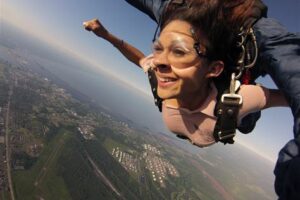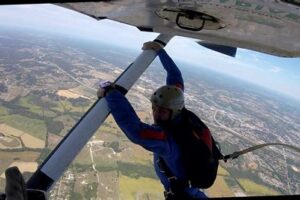Table of Contents
Skydiving deaths are a tragic reality in extreme sports. This article explores the risks associated with skydiving and highlights the importance of safety measures to prevent accidents. Learn about the statistics, causes, and preventive measures to help you understand the inherent dangers of this thrilling activity.
Skydiving is an exhilarating sport that offers a unique adrenaline rush to daredevils around the world. However, amidst the thrill and excitement, there is an undeniable risk that hangs in the air. Unfortunately, skydiving deaths have become a grim reality in recent years, raising concerns about the safety of this extreme activity. Despite the meticulous precautions taken by experienced instructors and the constant advancements in equipment technology, accidents do happen, and they can have devastating consequences. In order to fully grasp the gravity of these incidents, it is imperative to explore the causes, statistics, and potential preventive measures surrounding skydiving fatalities.
Skydiving Deaths: A Serious Concern for Adventure Seekers
Skydiving, a thrilling adventure sport that involves jumping from an aircraft and freefalling through the sky before deploying a parachute, is undoubtedly an adrenaline-pumping experience. However, despite the excitement it offers, skydiving carries inherent risks. Tragically, there have been numerous instances of skydiving accidents resulting in fatalities. This article delves into the topic of skydiving deaths, shedding light on the causes, preventive measures, and the importance of addressing this serious concern.
The Statistics Speak: Understanding the Numbers
While skydiving fatalities are relatively rare compared to the number of jumps performed each year, they still occur. According to statistics from the United States Parachute Association (USPA), there were 15 fatal skydiving accidents out of approximately 3.3 million jumps in 2020. Although the fatality rate has significantly decreased over the years due to safety advancements and regulations, every life lost is a tragic reminder of the risks involved.
Causes of Skydiving Deaths
Skydiving deaths can be attributed to various factors, including equipment malfunctions, human error, medical conditions, weather conditions, and unforeseen circumstances. Equipment malfunction, such as a failed parachute or a malfunctioning reserve chute, can turn a routine jump into a fatal incident. Additionally, errors made by skydivers during the jump, like improper body positioning or failure to deploy the parachute at the correct altitude, can have grave consequences.
Safety Measures: Training and Regulations
To mitigate the risks associated with skydiving, extensive training and adherence to strict regulations are crucial. Skydivers must undergo comprehensive training programs that cover safety procedures, parachute deployment techniques, emergency protocols, and proper body positioning during freefall. Additionally, regulatory bodies like the USPA continuously update safety guidelines and monitor drop zones to ensure compliance with industry standards.
The Importance of Equipment Inspection
Regular equipment inspection is paramount in preventing skydiving accidents. Parachutes, harnesses, and other gear must be meticulously inspected and maintained by trained professionals. Rigorous checks should be performed before each jump to detect any signs of wear, damage, or malfunction. Adhering to strict maintenance schedules and replacing aging equipment can significantly reduce the risk of equipment failure during a skydive.
Weather Conditions: The Unpredictable Factor
Weather conditions play a critical role in ensuring safe skydiving experiences. Strong winds, thunderstorms, fog, and low visibility can pose serious hazards to skydivers. Consequently, it is essential for skydiving operators to closely monitor weather forecasts and make informed decisions regarding jump operations. Canceling or rescheduling jumps when adverse weather conditions are present is a responsible choice that prioritizes the safety of skydivers.
Promoting Safety Culture within the Skydiving Community
A strong safety culture within the skydiving community is pivotal in preventing accidents. Encouraging open discussions about safety, sharing lessons learned from incidents, and continuous training and education are vital aspects of fostering a safety-oriented environment. By prioritizing safety and vigilance, both individual skydivers and organizations can contribute to minimizing the occurrence of skydiving deaths.
Supporting Research and Development
Continued research and development in the field of skydiving safety equipment and techniques are pivotal for enhancing the overall safety of the sport. Innovations such as advanced parachute designs, improved automatic activation devices, and enhanced training methodologies can significantly reduce the risk of fatalities. Investing in research and development is an investment in the lives of skydivers and the future of the sport.
Learning from Tragedy: The Importance of Investigation and Analysis
When a skydiving fatality occurs, conducting a thorough investigation and analysis is essential to understand the circumstances and prevent similar incidents in the future. Identifying contributing factors, evaluating safety protocols, and implementing necessary changes are crucial steps in ensuring continuous improvement and risk reduction within the skydiving community.
Conclusion: Balancing Adventure and Safety
Skydiving deaths serve as a stark reminder of the risks involved in this exhilarating sport. While skydiving can provide unforgettable experiences and a sense of freedom, it is imperative to acknowledge and address the risks responsibly. By prioritizing safety measures, promoting a strong safety culture, and supporting research and development, we can strive towards a balance between adventure and safety in the world of skydiving.
Analysis of Skydiving Deaths: Understanding the Risks Involved
Introduction to Skydiving: Thrills and Risks
Skydiving is an exhilarating adventure sport that involves jumping from an aircraft and freefalling before landing using a parachute. The adrenaline rush and breathtaking views attract thrill-seekers from all over the world. However, it is essential to understand and acknowledge the inherent risks associated with this activity to ensure participant safety.
Factors Contributing to Skydiving Fatalities
Several factors can potentially lead to skydiving fatalities, and it is crucial to analyze these factors to minimize the occurrence of accidents. Equipment failure, such as malfunctioning parachutes, can have fatal consequences. Improper training can leave skydivers ill-prepared to handle emergencies or unexpected situations. Poor weather conditions, such as high winds or heavy rain, can affect visibility and parachute capabilities. Human error, including ignoring safety protocols or participating under the influence of drugs or alcohol, can also lead to fatal consequences. Additionally, pre-existing health complications can increase the risk of accidents during freefall or parachute descent.
The Role of Parachute Malfunction
Parachute malfunction is one of the primary causes of skydiving fatalities. Issues with deployment, line twists, canopy entanglement, or failure to cutaway from a faulty parachute can significantly impact a skydiver’s chances of survival. Adequate training, regular equipment inspections, and adherence to safety procedures are critical for mitigating such risks.
Training and Certification: The Importance of Competent Instruction
Receiving proper training from certified instructors is vital for every skydiver. The initial training covers techniques for freefall, parachute deployment, emergency procedures, and canopy control. It is essential to ensure that individuals are competent and well-informed about safety procedures. By equipping skydivers with the necessary skills and knowledge, the likelihood of accidents can be greatly reduced.
Weather Conditions: Determining Safe Skydiving Opportunities
Adverse weather conditions pose significant risks for skydivers. High winds, heavy rain, fog, or thunderstorms can impact visibility, parachute capabilities, and landing accuracy. Monitoring weather conditions and following the guidance of experienced professionals is crucial to determining whether it is safe to jump. Safety should always be prioritized over the desire for thrill and adventure.
Human Error and the Need for Personal Responsibility
Maintaining a high level of personal responsibility is imperative in reducing skydiving-related accidents. Skydivers must adhere to safety protocols, avoid taking unnecessary risks, and make sound decisions to protect themselves and others. Ignoring safety procedures or participating under the influence of drugs or alcohol can lead to fatal consequences. Education and awareness campaigns can help instill a culture of personal responsibility within the skydiving community.
The Role of Medical Screening and Health Complications
Before engaging in skydiving activities, it is crucial for individuals to undergo medical screening to identify any pre-existing conditions that could potentially exacerbate during the jump. Health complications, such as heart ailments, respiratory issues, or seizures, can increase the risk of accidents during freefall or parachute descent. Consulting a healthcare professional before skydiving is essential for individual well-being and safety.
Maintaining Safety Standards: Learning from Past Incidents
Learning from past skydiving accidents is critical for improving safety standards. Detailed investigations of skydiving-related deaths provide valuable insights into the causes and potential preventive measures. The skydiving community should regularly evaluate safety protocols and implement enhancements to equipment and training techniques. Continuous improvement and a commitment to safety are essential for minimizing the risks associated with this adventurous activity.
Point of view: Skydiving Deaths
Skydiving is an exhilarating and adrenaline-pumping sport that allows individuals to experience the unparalleled thrill of freefalling from thousands of feet above the ground. However, like any extreme sport, skydiving carries inherent risks, and unfortunately, accidents resulting in fatalities do occur. In this professional analysis, we will examine the topic of skydiving deaths from a balanced perspective, considering both the dangers associated with the sport and the measures taken to mitigate those risks.
- The reality of risk: It is important to acknowledge that skydiving does involve a certain level of danger. Jumping out of an aircraft and hurtling towards the earth at high speeds naturally poses risks to the participants. Despite rigorous safety standards and stringent regulations, accidents leading to fatalities can still happen. These incidents are indeed tragic and deeply saddening for both the families affected and the skydiving community as a whole.
- Mitigating risks through regulation: The skydiving industry has made significant strides in ensuring the safety of its participants. Regulatory bodies such as the United States Parachute Association (USPA) and the International Parachuting Commission (IPC) have established comprehensive guidelines and safety protocols that all skydiving centers must adhere to. These regulations cover areas such as equipment maintenance, training requirements, and operational procedures. These measures are in place to minimize the likelihood of accidents occurring and to ensure that skydiving remains as safe as possible.
- Ongoing safety improvements: Skydiving organizations and manufacturers continuously invest in research and development to improve safety standards within the sport. Technological advancements in parachute design, harness systems, and automatic activation devices (AADs) have significantly reduced the risks associated with skydiving. Furthermore, the emphasis on comprehensive training and ongoing education for skydivers has greatly contributed to enhancing safety levels.
- Individual responsibility: While regulations and safety measures play a crucial role, it is essential to highlight the importance of individual responsibility when it comes to skydiving. Participants must be fully aware of the risks involved and take personal accountability for their actions. This includes maintaining physical fitness, following proper procedures, and being mindful of weather conditions before making a jump. By embracing a responsible mindset, skydivers can contribute to their own safety and that of others around them.
- Perspective on statistics: It is important to view skydiving death statistics within the broader context of the sport’s popularity and participation rates. Although any loss of life is tragic, the number of fatalities resulting from skydiving accidents remains relatively low when compared to the large number of jumps conducted each year. While every incident is regrettable, it is worth recognizing that skydiving is statistically safer than many other recreational activities.
In conclusion, skydiving deaths are undoubtedly unfortunate events that highlight the inherent risks associated with this extreme sport. However, it is crucial to acknowledge the efforts made by the skydiving industry to mitigate these risks through stringent regulations, technological advancements, and comprehensive training. By promoting individual responsibility and maintaining perspective on statistics, the skydiving community continues to strive for improved safety standards. While tragedies do occur, it is the collective commitment to safety that allows individuals to pursue their passion for skydiving while minimizing the likelihood of accidents resulting in fatalities.
Dear blog visitors,
We would like to take a moment to address a sensitive topic that has been making headlines and causing concern among many: skydiving deaths. While it is important to acknowledge the risks associated with this extreme sport, it is equally crucial to understand the broader context and statistics surrounding these incidents.
First and foremost, it is essential to recognize that skydiving, like any adventure activity, carries inherent risks. The act of jumping out of a plane and freefalling from thousands of feet in the air naturally involves certain dangers. However, it is vital to put these risks into perspective. According to the United States Parachute Association, the fatality rate for skydiving in the US is remarkably low, with an average of around 0.006 fatalities per thousand jumps. This statistic demonstrates that skydiving is generally a safe activity when proper precautions are taken and safety guidelines are followed.
Furthermore, it is crucial to emphasize that the skydiving industry is dedicated to minimizing risks and ensuring the safety of its participants. Skydiving centers adhere to strict regulations and guidelines set by national and international governing bodies. These guidelines cover everything from equipment maintenance to training protocols, with the ultimate goal of providing a safe and enjoyable experience for all skydivers. In fact, modern skydiving equipment is meticulously designed and rigorously tested to maximize safety and minimize the likelihood of accidents.
Lastly, it is important to remember that every individual’s perception of risk varies. While some may consider skydiving to be an extremely dangerous activity, others view it as an exhilarating and rewarding experience worth pursuing. Ultimately, the decision to engage in skydiving lies with each person, taking into account their own comfort level and understanding of the risks involved.
In conclusion, while skydiving deaths are indeed tragic and can garner significant media attention, it is important to approach the topic with a balanced perspective. By considering the low fatality rate in relation to the number of jumps made each year and recognizing the industry’s commitment to safety, we can better understand the true level of risk involved. As with any adventure sport, it is crucial for individuals to make informed decisions and prioritize their safety above all else. If you choose to embark on a skydiving adventure, ensure you do so with a reputable and experienced skydiving center that prioritizes safety. Happy and safe skydiving!
Sincerely,
The Blog Team
Video Skydiving Deaths
People also ask about skydiving deaths:
-
How common are skydiving deaths?
Skydiving deaths are relatively rare. According to statistics, the fatality rate for skydiving is around 0.006% per jump or approximately 1 in every 167,000 jumps. While it is impossible to completely eliminate the risks associated with any extreme sport, skydiving has become much safer over the years due to advancements in equipment, training, and safety regulations.
-
What are the main causes of skydiving deaths?
The main causes of skydiving deaths can vary, but some common factors include human error, equipment malfunction, and unforeseen circumstances. Human error, such as failure to follow proper procedures or disregard for safety guidelines, can lead to accidents. Equipment malfunction, although rare, can occur if there are issues with the parachute or other gear. Unforeseen circumstances like sudden changes in weather conditions can also contribute to accidents.
-
Are tandem skydives safer than solo jumps?
Yes, tandem skydives are generally considered safer than solo jumps, especially for beginners. In a tandem skydive, you are attached to an experienced instructor who controls the entire jump. This allows you to enjoy the experience without having to worry about deploying the parachute or other technical aspects. Tandem skydives have a lower fatality rate compared to solo jumps due to the added guidance and expertise of the instructor.
-
Can skydiving accidents be prevented?
While it is impossible to completely eliminate the risk of accidents in any extreme sport, skydiving accidents can be minimized through proper training, adherence to safety protocols, and regular equipment maintenance. It is crucial for skydivers to receive thorough training from certified instructors, follow all safety guidelines and procedures, and use well-maintained gear. Staying updated on the latest safety practices and regulations is also important.
-
What safety measures are in place to prevent skydiving deaths?
The skydiving industry takes safety very seriously and has implemented various measures to prevent deaths and accidents. These include rigorous training programs for instructors and jumpers, regular equipment inspections, strict adherence to safety protocols, and continuous improvement of safety standards. Additionally, skydiving centers often work closely with aviation authorities to ensure compliance with regulations and maintain a safe operating environment.
It’s important to note that while skydiving carries inherent risks, millions of people safely enjoy this thrilling activity every year. By taking appropriate precautions and choosing reputable skydiving facilities, individuals can minimize the risks associated with skydiving.






